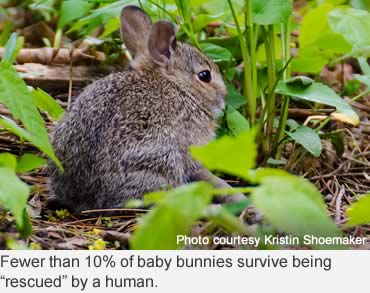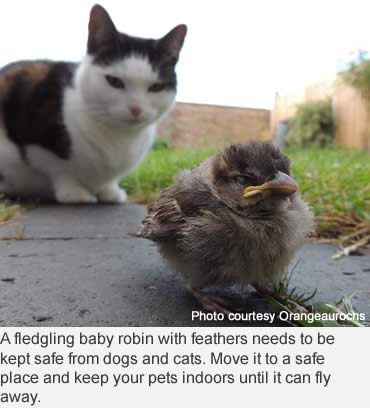Photo: This newborn fawn is so new his mom hasn’t had time to hide him yet.
April through September are busy months for wildlife moms and babies. Warm weather arrived and wooded areas and back yards are filled with newborns—deer, birds, rabbits, squirrels and raccoons. Chances are, you may find a wildlife baby all alone, seeming helpless, and you’ll want to rescue it. Please don’t.
It’s hard to resist a fallen baby bird, a tiny rabbit or a nest of them, or a fawn looking lost and alone, almost out of sight. What kind-hearted person wouldn’t want to help the adorable, cuddly creatures?
If you think they need your help, please STOP. Leave the area. The babies are fine, and their mother has left on purpose to find food for herself so she can feed her young. She has not abandoned her babies, but if you pick them up or take them away from where their mother left them, you’ll be kidnapping them, endangering them and, very likely, shortening their life span.
But . . . that baby looked like needed help! Maybe not. Here are some guidelines wildlife professionals recommend.
BABY DEER
During their first few weeks of life, fawns do not attempt to evade predators. Instead, they remain still to avoid being seen. A doe cannot be in two places at one time, so she hides her fawn—often twins in separate locations—from predators in secluded areas like a flower bed, garden or even a roadside ditch.
 A hidden fawn has virtually no scent, so it is difficult for predators to find it. The doe is typically nearby and tends her fawn four to six times a day during its first few weeks of life, less frequently when it is older. If the fawn is lying quietly, leave it alone, and leave the area. Does won’t reject their fawns if human scent is near, but it’s a bad idea to touch the fawn or linger in the area. If you do, you’ve added a layer of human scent and it could invite a curious coyote or dog or to investigate, endangering the fawn.
A hidden fawn has virtually no scent, so it is difficult for predators to find it. The doe is typically nearby and tends her fawn four to six times a day during its first few weeks of life, less frequently when it is older. If the fawn is lying quietly, leave it alone, and leave the area. Does won’t reject their fawns if human scent is near, but it’s a bad idea to touch the fawn or linger in the area. If you do, you’ve added a layer of human scent and it could invite a curious coyote or dog or to investigate, endangering the fawn.
If you find a fawn wandering or crying, it is frightened. Is it near the side of a road? Is there an injured or dead doe nearby? Now is the time to intervene by calling a wildlife rehabilitator. Use your cell phone to look up “wildlife rehabilitators near me” and call for help.
Just as important: Do not attempt to feed the fawn. Keep others and pets away from the fawn until help arrives.
BABY BIRDS
It isn’t unusual in spring and early summer to find a baby bird on the ground. Many birds are hatching and often leave or fall from their nests before they are able to fly. If the bird does not have feathers, put it back in the nest.
If you can’t find the nest, put it on a branch or safely out of reach of cats and dogs. If the bird has feathers, leave it alone. If it is hopping on the ground, it isn’t a baby, but a fledgling, and very close to taking its first flight. If the bird is not in danger, leave it where you found it. The mother bird will find and feed it on the ground.
Do not feed baby birds or fledglings. Birds have a very specific diets and feeding them something that’s not part of their diet can kill them.
You may find a bird nest in an unusual spot, perhaps wedged inside wreath on your front door or in the eaves of your house. Do not move nests if there are eggs or baby birds inside. It may seem a nuisance but wait until baby birds leave the nest before removing the nest from its awkward location.
Also, if you plan to prune shrubs, always take a good look at inner branches to see if there are nesting birds inside.
BABY BUNNIES
Wild rabbits hide their nests in plain sight, and often in the open or the middle of a lawn, in long grass or a brush pile. If you find a nest that’s been disturbed, restore and protect it from cats and dogs. Mama rabbit may not be easily seen, but she is nearby. Female rabbits, also known as does, return to their nests at night and to call and feed their babies.
 Do not attempt to save a nest of wild rabbits. According to the House Rabbit Society, the reality is that fewer than 10% of the “orphaned” rabbits people try to “save” will survive a week. The best thing you can do is to cover the nest with grass or twigs and keep your dog or cat away from it. Also, do not attempt to feed or move the wild bunnies.
Do not attempt to save a nest of wild rabbits. According to the House Rabbit Society, the reality is that fewer than 10% of the “orphaned” rabbits people try to “save” will survive a week. The best thing you can do is to cover the nest with grass or twigs and keep your dog or cat away from it. Also, do not attempt to feed or move the wild bunnies.
CATS
If you have a pet cat, be kind to the wildlife babies and keep your cat indoors. Your sweet kitty is a wildlife predator, and domesticated cats have killed millions of birds as well as other baby mammals. Cats that stay indoors also live longer and healthier lives.
State and federal laws protect and regulate wildlife, and typically only trained and licensed wildlife rehabilitators can possess or care for native wildlife. The laws are in place for the benefit of humans and well as wild animals.
Resources—Alabama Cooperative Extension System, Utah Division of Wildlife Resources, the House Rabbit Society, Cornell Lab of Ornithology.